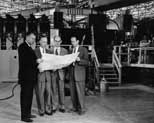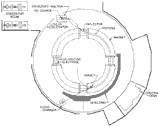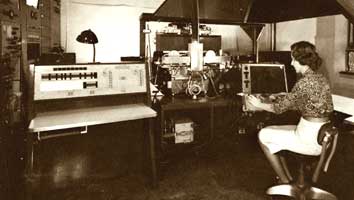|
|
General: COLD WAR SCIENCE ERNEST LAWRENCE (HOLY GRAIL) CYCLOTRON
Choisir un autre rubrique de messages |
|
|

 |
Cold War Science
Up on the lawns of Washington the physicists assemble
From all the land are men at hand, their wisdom to exchange.
A great man stands to speak, and with applause the rafters tremble.
"My friends," says he, "you all can see that physics now must change.
"Now in our lab we had our plans, but these we'll now expand,
Research right now is useless, we have come to understand.
We now propose constructing at an ancient Army base,
The best electro-nuclear machine in any place.
"Oh – it will cost a billion dollars, ten billion volts ‘twill give,
It will take five thousand scholars seven years to make it live.
All the generals approve it, all the money's now at hand,
And to help advance our program, teaching students now we've banned."
– "Take Away Your Billion Dollars," by Arthur Roberts (1946), who later commented: "I was impressed by the number of people who thought that it was aimed at them."
Listen to the song, see the full text, plus more songs
|
|

Relative sizes, magnet weight, and cost of the earliest accelerators at Berkeley.

General Groves and UC President Sproul admire Lawrence's Medal for Merit for war-time service.
|
The contributions of Ernest Lawrence and his Radiation Laboratory to the war effort helped forge a new compact between science and the federal government. When Lawrence sketched his postwar plans in 1944, he expected his Berkeley lab would revert to its prewar size and modes of funding, with a budget of about $85,000 a year. By May 1945, however, he had scaled up his plans to a postwar annual budget of $1 million, and by December he had tripled that. Lab alumni were returning from their wartime postings, among them Luis Alvarez and Edwin McMillan with ideas for new accelerators, and the 184-inch magnet awaited conversion from a Manhattan Project calutron to a research cyclotron.
Lawrence was on good terms with General Groves and the Army, thanks to his experience with the Manhattan Project. He backed a bill in the U.S. Congress that would hand control of atomic energy to the military. The bill roused the opposition of other scientists, who feared military domination of research and supported legislation that would ensure civilian control. Lawrence withdrew from the debate, disapproving of public political activism by scientists and preferring instead to work with officials as an insider. Groves reciprocated Lawrence's support by agreeing to fund new projects in Berkeley with government money. That included completing the 184-inch machine, an electron synchrotron for McMillan, a linear particle accelerator under Alvarez, and a nuclear chemistry lab for Glenn Seaborg.
"There [is] no limit on what we can do but we should be discreet about it."
—Lawrence on the prospects of government support in 1946
 Ernest O. Lawrence lunching with future United States president Dwight Eisenhower and former United States president Hoover Ernest O. Lawrence lunching with future United States president Dwight Eisenhower and former United States president Hoover
at Bohemian Grove, July 23, 1950.
|
| |
|
 |

Construction of linear accelerator. |

Schematic diagram of linear accelerator. |
 |
|
|
 Lawrence and staff posing with the magnet for the 184-inch synchrocyclotron. Lawrence and staff posing with the magnet for the 184-inch synchrocyclotron.

"Old Town" �the city of the 184-inch cyclotron� during the peaceful days after the war.
|
The war gave scientists not only new funding sources but new ideas and instruments. Alvarez's particle accelerator used techniques from his wartime work on high-frequency devices for radar. The 184-inch cyclotron and the electron synchrotron both used an idea McMillan had developed at Los Alamos. Back in 1937, failure had been foretold for the big cyclotron. Physicists at Cornell pointed out that, according to Einstein's theory of relativity, the mass of the accelerated particles would increase as they approached the speed of light. Particles would thus fall out of step with the cyclotron's accelerating fields, and could not reach higher energies. Lawrence had been confident a way around the problem would be found. In 1945 McMillan suggested a solution (Soviet physicist Vladimir Veksler independently had the same idea in 1944). He proposed to keep the increasingly massive electrons in step by changing the frequency of the accelerating electric field. In November 1946, the 184-inch frequency-synchronized cyclotron, or "synchrocyclotron," gave its first beam. At 195 MeV the deuterons had double the energy of what was planned in 1940.
"We have learned from repeated experience that there are many ways of skinning a cat."
—Lawrence to Hans Bethe in 1937,
insisting that theoretical limits to the cyclotron would be overcome.
|
 |
Meanwhile Congress took nuclear research from military control and gave it to a civilian Atomic Energy Commission. Lawrence had lobbied the AEC to support the construction of even bigger accelerators, convincing them the results would be worth the huge expense. But the Berkeley team faced competition from a collection of scientists in the northeastern states. In 1947 they founded the Brookhaven National Laboratory on Long Island in New York and asked the AEC for their own accelerator. After several rounds of proposals and counter proposals, the AEC agreed to support new proton synchrotrons at both labs. Brookhaven would build quickly to reach 3 BeV (a BeV, now called a GeV, is a billion electric volts). Berkeley aimed to construct a 6 BeV machine with a 10,000 ton magnet, the "Bevatron."
|
 |

John P. Blewett, c. 1949, a major contributor to accelerator design and particle physics at Brookhaven. |

Construction of the "Bevatron"
|
|

Lawrence making plans for another big machine.

Schematic of the "Bevatron."
|
 |
| View of tracks in window of 72" bubble chamber. |
Both machines had enough energy to produce particles that had so far been seen only in cosmic rays. In 1947 observations of cosmic rays in England had identified a mysterious new group of particles–now called mesons–which were heavier than electrons but lighter than protons or neutrons. The Brookhaven and Berkeley machines at first were conceived to reach energies high enough to create these particles. In the meantime, however, a group in Berkeley managed to detect mesons from the 184-inch synchrocyclotron. So while Brookhaven went on to explore meson physics, Lawrence and his staff designed the Bevatron to reach an energy high enough to create protons. The 184-inch machine went on to produce the neutral pion, the first particle detected initially at an accelerator.
The Bevatron, finished in 1954, enabled the detection of the anti-proton in 1955, earning Segr� and Owen Chamberlain a Nobel Prize in physics four years later. New detection devices including fast electronic logic circuits and the bubble chamber, built on a grand scale by Alvarez in the Berkeley style, helped physicists through the 1950s to produce and investigate dozens of new particles. In place of the few elementary particles known to physicists before the Second World War, they now had to deal with an entire zoo of particles.
|
|

|

Computers helped reduce bubble-chamber film to machine-readable data.
|
|
|
|
 Premier
Premier
 Précédent
Sans réponse
Suivant
Précédent
Sans réponse
Suivant
 Dernier
Dernier

|
|
|
| |
|
|
©2025 - Gabitos - Tous droits réservés | |
|
|

